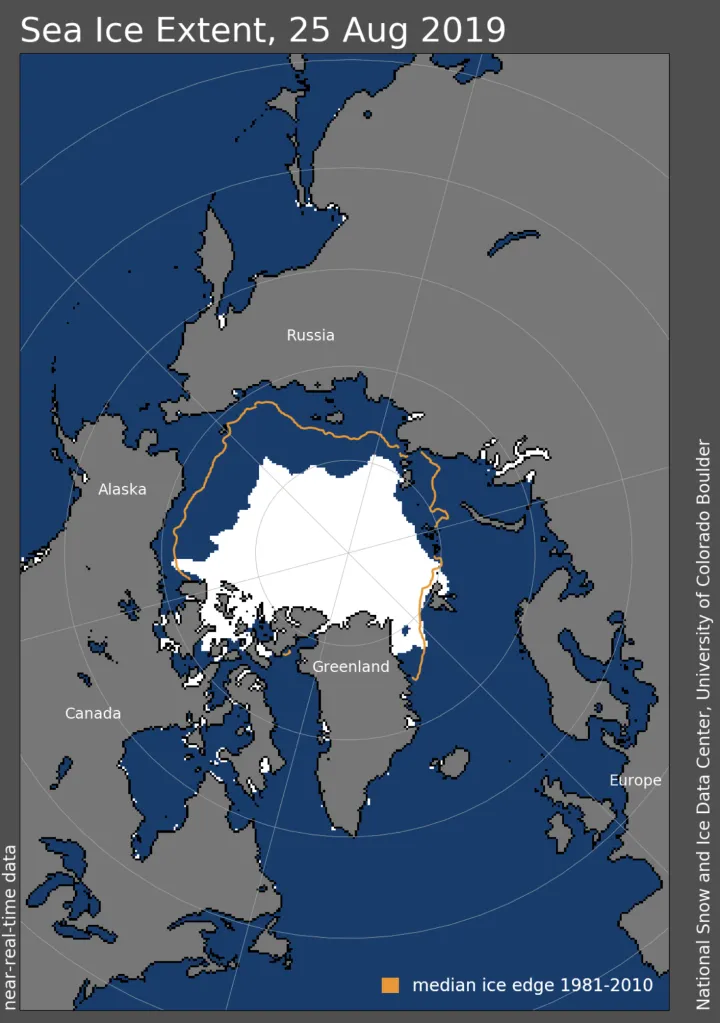What is the Sea Ice Minimum? (And Why Do We Care)

Envision the Arctic and an icy, white world comes to mind. Unlike Antarctica, which is a continent, much of the Arctic “landscape” is actually ocean covered by year-round ice. It is the ice that provides a habitat for polar bears and walruses to rest on and keeps the marine environment in balance so that sea life can thrive. But that world is rapidly disappearing.
Every year the sea ice grows and shrinks in accordance with the seasons. In the Northern Hemisphere winter, the ice coverage expands to cover the majority of the Arctic Ocean by March—the month of yearly maximum. In the summer it rapidly shrinks until it hits its smallest size in September—the month of yearly minimum. Permanent, year-round ice in the Arctic has existed for the majority of the last 350,000 years and now we are losing that ice at a rate that could be the highest in the last 1,500 years.
In the last decade, both the sea ice maximum and the sea ice minimum have seen record lows. As of the end of 2018, the last 12 summers are also the 12 lowest years for sea ice minimum coverage since the late 1970s, when a consistent satellite record of the sea ice cover began. The last four years also represent the lowest sea ice maximums ever recorded.
For scientists who have spent their careers monitoring the Arctic, the loss in ice became apparent roughly 20 to 30 years ago. “It hit home in 2007,” said Ken Dunton, a marine ecologist at the University of Texas. “That was the summer we saw tremendous erosion of the Arctic coastline.” Ecological data can often be messy. With so many variables affecting the ice, the overall decreasing trend can get lost. By 2007 the trend was clear, the Arctic was becoming markedly different than the place humans had known previously.
Alarms sounded again in 2012. Persistent warm conditions throughout that year’s summer and a late cyclone that brought warm air north in August created the perfect storm for melting. The year would mark the lowest Arctic ice coverage since the satellite record began, about 293,000 square miles (760,000 square kilometers) below the previous record minimum extent, a reduction exceeding the area of the state of Texas.
For many people, the Arctic is a foreign and almost otherworldly place. Why would decreasing sea ice matter to someone living in Houston, Nairobi, Tehran, or Berlin? The reality is that Arctic ice plays a major part in regulating the Earth’s climate. Snow-covered ice in the Arctic reflects over 80 percent of the sun’s incoming rays back to space, so as the ice melts it increases the rate at which the Earth is warming. Scientists refer to this phenomenon as a positive feedback system—the warming planet melts the ice which speeds up global heating since more of the sun’s rays are being absorbed. Sea ice loss could also be connected to the weather in your backyard and impact the movement of the all-important jet stream.
As the ice melts, the world warms. In 2019, Alaska experienced record-breaking heat roughly 5 degrees Fahrenheit higher than normal, spurring an unprecedented wildfire season. July 2019 was the hottest month ever recorded and saw Europe sweltering in a record-smashing heatwave. That heat system then turned north and caused unprecedented melting of the Greenland Ice sheet. In Honduras, a severe, multi-year drought is causing multigenerational farms to go belly up and inhospitable conditions are leading people to leave their homeland in search of security and stability.
And although changes in sea ice do not affect sea level, melting land ice will cause sea level to rise, which will have significant implications for people and environments in low lying coastal areas. Ocean heatwaves are also on the rise, and the intensity of these heatwaves are causing more severe coral bleaching events than in previous years. Not all regions are suffering, and some are even benefiting from the altered conditions. But should we continue to rely on fossil fuels it is realistic that worsening climate conditions will occur on a widescale basis.
And so, as the ice melts in response to human activity the world will have to adapt. The question still remains, are we up for the task?


